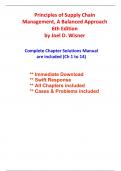Principles of Supply Chain
Management, A Balanced Approach
6th Edition
by Joel D. Wisner
Complete Chapter Solutions Manual
are included (Ch 1 to 14)
** Immediate Download
** Swift Response
** All Chapters included
** Cases & Problems included
, Solution and Answer Guide
Joel Wisner, Keah-Choon Tan, G. Keong Leong, Principles of Supply Chain Management: A Balanced
Approach, 6e, © 2023, 978-0-357-71560-4; Chapter 01: Answers to Questions/Problems
Table of Contents
Discussion Questions ............................................................................................................ 1
Cases .................................................................................................................................. 8
Learning Objectives: ..................................................................................................................................... 8
Answers to Questions .................................................................................................................................. 8
Appendix 1.1 The Beer Game................................................................................................ 9
Questions and Exercises .............................................................................................................................. 9
Discussion Questions
1. Define the term supply chain management in your own words and list its most important
activities.
Answers:
The Supply-Chain Council’s definition of supply chain management is “managing supply and
demand, sourcing raw materials and parts, manufacturing and assembly, warehousing and
inventory tracking, order entry and order management, distribution across all channels, and
delivery to the customer.
These are also the most important activities; however, integration of key supply chain processes
might also be included in there.
2. Can a small business like a local sandwich or bicycle shop benefit from practicing supply chain
management? What would they most likely concentrate on?
Answers:
Yes, any organization can implement at least some of the important concepts. A good place to
start is the rationalization or reduction of the supply base. Small businesses might also want to
concentrate on customers as a starting point.
3. Describe and draw a supply chain for a bicycle repair shop and list the important supply chain
members.
Answers:
This will vary from student to student, but should include, for instance, parts suppliers, bicycle
suppliers, and other suppliers (i.e., helmet suppliers) and services (i.e., repair services) as first-
tier suppliers and bicycle owners as first-tier customers.
, 4. Can a bicycle repair shop have more than one supply chain? Explain.
Answers:
Yes. Every repair item the firm stocks has potentially a different supply chain associated with it.
5. What is a cold chain? Why did it become so important in 2020?
Answers:
A cold chain is an alliance of companies that can monitor and protect the temperature of
perishable products to maintain quality and safety from the point of origin through distribution to
the final consumer. Cold chains became a popular news item in 2020 as COVID-19 vaccines
began to be distributed globally by Pfizer and Moderna. The two vaccines must be stored and
transported at sub-zero temperatures.
6. How has the recent global pandemic impacted supply chain management?
Answers:
In general, it made things more difficult, particularly for global supply chains—companies have
gone bankrupt, retailers have stopped buying regularly, ports have shut down unexpectedly, and
many purchases have gone online as people stayed home. Companies have had to react quickly
to the changes.
7. What roles do “collaboration” and “trust” play in the practice of supply chain management?
Answers:
This is essential for process integration. Sharing information and determining joint strategies is
part of the process of integration and collaboration, and to do this, trust must be present
between the customer, focal firm, and supplier.
8. Why don’t firms just become more vertically integrated (for example buy out suppliers and
customers), instead of trying to manage their supply chains?
Answers:
This could cause a loss of focus and keep managers and employees from doing their core
competencies, resulting in loss of performance.
9. What types of organizations would benefit the most from practicing supply chain management?
What sorts of improvements could be expected?
Answers:
Firms with many suppliers, many complex products, large inventories, and many customers (in
other words, firms with many supply chains). Gains would be lower purchasing costs, lower
carrying costs, better product quality, and better customer service.
10. What are the benefits of supply chain management?
Answers:
Reduction of the bullwhip effect, better buyer/supplier relationships, better quality, lower costs,
better customer service, higher demand, and more profits.




